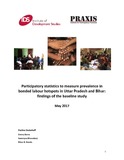| dc.contributor.author | Oosterhoff, Pauline | |
| dc.contributor.author | Burns, Danny | |
| dc.contributor.author | Bharadwaj, Sowmyaa | |
| dc.contributor.author | Nanda, Rituu B. | |
| dc.coverage.spatial | India | en |
| dc.date.accessioned | 2017-10-19T13:13:49Z | |
| dc.date.available | 2017-10-19T13:13:49Z | |
| dc.date.issued | 2017-05 | |
| dc.identifier.uri | https://opendocs.ids.ac.uk/opendocs/handle/20.500.12413/13294 | |
| dc.description.abstract | The Institute of Development Studies has been carrying out a programme of research, learning and evaluation in relation to the Freedom Fund ‘hotspot’ in northern India, a project that seeks to reduce bonded labour in the states of Uttar Pradesh and Bihar.
The work for this baseline study builds upon scoping visits comprising interviews with NGOs, focus groups with community members, field observations, the participatory collection and analysis of 353 life stories to identify the most significant indicators of change, and the generation of a baseline of participatory statistics of 3466 households across 82 hamlets in locations covered by 14 NGOs. This will be followed by the rollout of a systemic action research programme which combines stakeholders analysing and developing solutions to their problems with follow-up participatory statistical analysis. We will conduct an end-line survey two years after the data collection for this study has been completed.
The aim of the study was to estimate the prevalence of bonded labour in the selected intervention communities of the Freedom Fund hotspot in northern India. Prevalence data help mainly to understand the profile of families in bonded labour and any correlations with different variables. The analysis of life stories provided a better insight into the life situations of families in bonded labour and explored questions of why and how. With clear causal factors emerging from the life story analysis, the current prevalence study was able to focus on these important indicators. The team facilitated a discussion on the results at the end of the data collection process in each site. These discussions focused on the reasons for the differences in prevalence results using the tallied-up data to explore how gender, age and caste dynamics shape bonded labour, with most adults in bonded labour working inside the village; most boys in bondage working outside the village; and a group of families with all members in bonded labour working outside the village. | en |
| dc.description.sponsorship | Freedom Fund | en |
| dc.language.iso | en | en |
| dc.publisher | IDS | en |
| dc.rights.uri | http://www.ids.ac.uk/files/dmfile/IDSOpenDocsStandardTermsOfUse.pdf | en |
| dc.subject | Gender | en |
| dc.subject | Participation | en |
| dc.subject | Work and Labour | en |
| dc.title | Participatory Statistics to Measure Prevalence in Bonded Labour Hotspots in Uttar Pradesh and Bihar: Report of Preliminary Findings of the Baseline Study | en |
| dc.type | IDS Research Report | en |
| dc.rights.holder | IDS | en |
| dc.identifier.team | Gender and Sexuality | en |
| rioxxterms.funder | Default funder | en |
| rioxxterms.identifier.project | Modern Slavery in India and Nepal | en |
| rioxxterms.version | AO | en |
| rioxxterms.funder.project | a275340f-6b0f-4bd6-99a7-5f8a2274540d | en |

